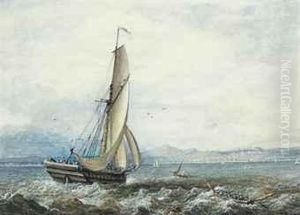Thomas Grieve Paintings
Thomas Grieve was a prominent British scene painter in the 19th century, known for his work in the theatre. Born in 1799, Grieve came from a family with a strong connection to the theatrical world; his father, also named Thomas Grieve, was a respected painter of theatrical scenery as well.
Following in his father's footsteps, Thomas Grieve became one of the most esteemed scene painters of his time. He was associated with the Theatre Royal, Drury Lane, where he worked alongside other notable figures in the field such as his brother, William Grieve, and the well-known stage designer Clarkson Stanfield. Together, they contributed to the golden age of British theatre, bringing to life the visions of playwrights and impressing audiences with their skillful and imaginative stage designs.
Grieve's work was characterized by its attention to detail and its ability to create a sense of depth and realism on stage. His painted backdrops and elaborate sets helped to transport viewers to a variety of settings, from the fantastical to the historical. His talent was not only in high demand for live theatre productions but also for public spectacles and exhibitions, which were immensely popular during the Victorian era.
Despite the ephemeral nature of stage design, with many pieces being painted over or destroyed after performances, Grieve's legacy lives on through descriptions of his work and the influence he had on the field of scene painting. Thomas Grieve's career spanned many decades, and he continued to work until his later years, contributing to the visual splendor of 19th-century British theatre until his death in 1882.
